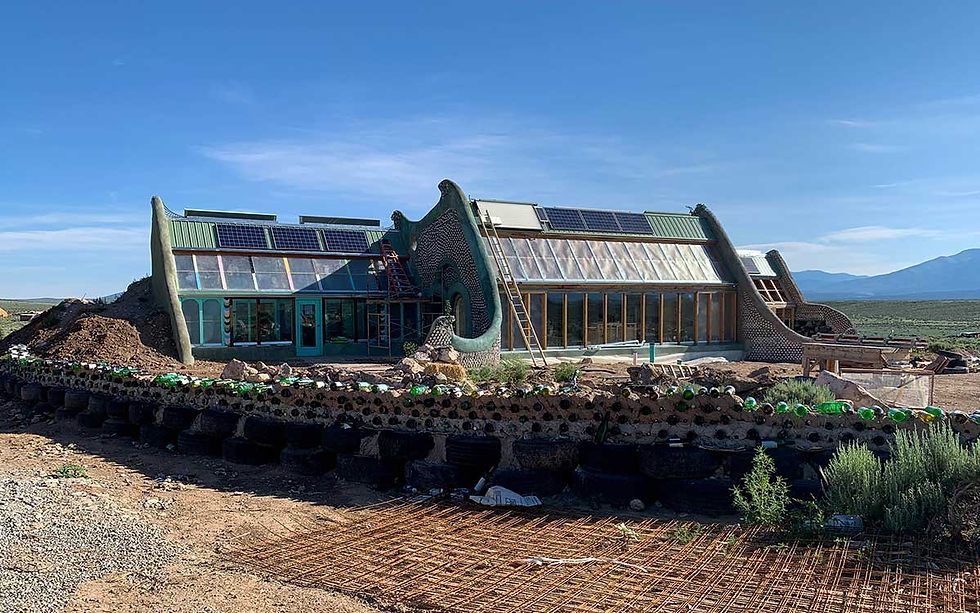Earthship Communities in New Mexico for Doomsday Preppers??
- BusNewsNetwork
- Feb 1
- 4 min read
Updated: Feb 1

In the dry landscapes of New Mexico, a special way of living is gaining attention—Earthship communities. These homes are built using recycled materials and designed to function independently from traditional utilities. As concerns about climate change, economic instability, and social collapse grow, many are looking at Earthships as a way to form self-sufficient communities. In this article, we explore the intriguing world of Earthships and their appeal to doomsday preppers.
What Are Earthships?
Earthships are passive solar homes constructed primarily from natural and recycled materials like tires, bottles, and adobe. They serve as more than just shelter; they utilize the earth's resources to create comfortable living spaces. A defining feature of Earthships is their off-grid capability. They can generate their own electricity, collect rainwater, and even provide opportunities for indoor gardening. In fact, many Earthships can reduce energy costs by up to 70% through these sustainable practices, making them highly attractive for those who value independence.
The Earthship concept was first introduced by architect Michael Reynolds in the 1970s. Since then, numerous Earthship communities have emerged, particularly in New Mexico, each with unique designs but all united by a focus on eco-friendly living.

The Appeal for Doomsday Preppers
Doomsday preppers are individuals or groups who prepare for potential disasters that could disrupt society, such as natural catastrophes or economic downturns. Earthships are particularly appealing to these individuals because of their self-sufficiency.
Standard homes often rely on external utilities that might fail in a crisis. In contrast, Earthships operate independently, which aligns with the prepper mindset. For instance, the ability to generate electricity from solar panels or wind turbines minimizes dependence on outside sources. A study found that homes in Earthship communities can reduce their utility costs by up to 90% in some cases. This reliance on renewable resources resonates deeply with those planning for uncertain futures.
Community Living and Collaboration
Life in an Earthship community promotes collaboration and mutual aid. Residents often share resources, work together on projects, and organize workshops to teach sustainable living techniques. This sense of solidarity is particularly appealing to preppers, as it fosters a network of support.
Living closely with others allows individuals to pool their skills and resources. For example, one resident might be knowledgeable in organic gardening, while another may have construction skills. Together, they can strengthen their overall preparedness. By sharing information and tools, residents can enhance their readiness for whatever challenges may arise.

Sustainable Practices
Earthship living incorporates various sustainable practices that appeal to both preppers and environmentally conscious individuals. Key features include:
Renewable Energy: Earthships often come equipped with solar panels and wind turbines, allowing residents to use clean energy and eliminate fossil fuel dependency.
Water Harvesting: Rainwater is collected from rooftops and filtered for drinking, significantly reducing the need for city water supplies.
Greywater Systems: Water from sinks and showers is recycled for gardening, cutting down on waste while providing vital resources for plants.
Food Production: Many Earthship designs integrate food growing opportunities directly into living spaces. With indoor gardens and greenhouses, residents can enjoy fresh produce year-round.
These sustainable practices not only bolster the prepping mindset but also foster a lifestyle ready to withstand future challenges.
Challenges Faced by Earthship Communities
Though Earthship communities offer many advantages, they also come with challenges. One significant issue is the acceptance from local governments and regulatory bodies, which can complicate building permits and zoning laws. In some locations, these regulations can significantly slow down the establishment of Earthship homes.
Furthermore, living in remote areas may introduce risks concerning access to supplies and emergency services, which is crucial for preppers. Careful location assessment is essential to ensure that residents have the resources and connections needed to thrive in potentially isolated settings.
Finding Your Place in an Earthship Community

For those curious about joining an Earthship community, several options exist in New Mexico. Earthship Biotecture in Taos is known for its educational programs and workshops, guiding individuals on how to build their own Earthships and integrate into the community.
Before making a commitment, prospective residents may want to engage in volunteer projects or internships within established Earthship communities. This gives an authentic feel for the lifestyle. Connecting with current Earthship residents can also provide valuable insights into the daily realities of this unique way of living.

Embracing a New Way of Living
The charm of Earthship communities in New Mexico offers compelling possibilities for doomsday preppers focused on sustainability and independence. By adopting eco-friendly principles, these communities create resilient lifestyles suitable for uncertain times. It's crucial, however, to navigate the challenges associated with this distinctive way of life and actively engage with the Earthship community for a complete understanding of the experience.
As society faces various uncertainties, Earthship communities remind us of human creativity and proactive approaches to sustainable living. Whether seen as a strategy for readiness or a choice rooted in environmental responsibility, Earthships inspire us all to consider how we live and envision the future of our planet.




Comments